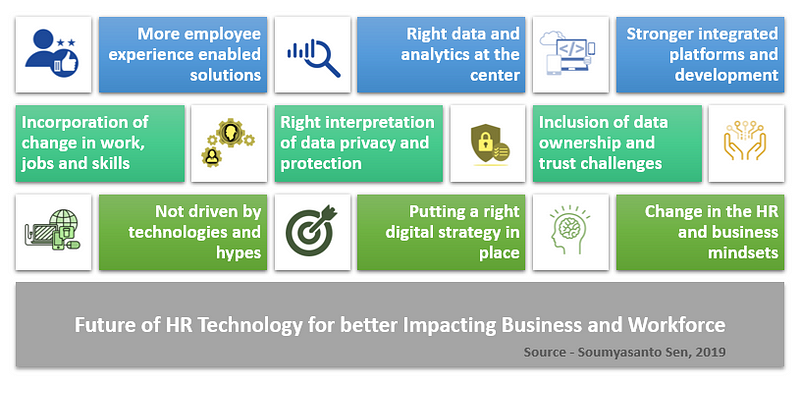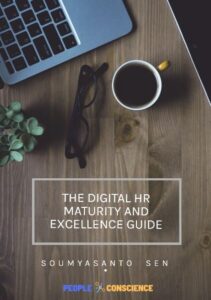In today’s world, HR technology is no longer just a way to support HR processes, it’s so much more than that. It is, however, unfortunate that when we see our current HR technology investments and landscape, the value that it creates for the business and the workforce is often nominal. If we try to assess the current value that HR technologies offer, I think it is safe to say that a majority of us will agree that out of 10, it ranks less than 5 (for me it’s even lower than 4). In many situations, HR technology is focusing on HR, rather than the value it can deliver to the business and workforce. This begs the question; how can we drive greater value for the business and workforce with future HR technologies?
Throughout this blog I’ll discuss the top nine areas where HR technology can have the biggest impact and empower the business:

1. More employee experience enabled solutions
The concept of employee experience (EX) and EX initiatives are no longer considered ‘new’, but the question that arises is ‘how much value are these initiatives delivering to the employee?’ There is still a lot of room for improvement in regard to the experiences, moments that matter and the adoption of platforms that exist with respect to HR technologies. In most cases, these EX initiatives are restricted to the employee journey and miss the wider organisational journey experiences from culture and technology to the workplace. In many situations, these initiatives do not span across all of the HR customer segments that exist from the candidates and managers to executives and blue-collar workers. Implementing a single tool will not fix EX. The employee experience goes far beyond one tool or one system. It needs to be a seamless experience across multiple platforms. Josh Bersin’s suggestion of an EX platform is an example of a solution that provides both values to the employee as well as other workforce segments. Going forward it’s imperative that we not only introduce more experience-driven solutions but that we ensure that we are integrating future HR technology to provide a seamless end to end experience.
2. Right data and analytics at the center
People or HR analytics are fast becoming the heart of organisations today. Organisations that make data-driven decisions about their people can achieve higher performance, better results, and a superior return on outcomes than those that don’t. However, for many organisations its nothing more than reports, dashboards, metrics and some nice fancy visualisations. The right data and analytics can add huge value to the business, as suggested by David Green, it can support us in making better decisions for a multitude of business problems, whether they’re related to joining, leaving, performance, pay, retention, engagement, or culture. Current HR technology solutions are no doubt improving but there are still challenges that exist while integrating this with the other business data, such as finance or sales data. More emphasis needs to be placed on HR technology and analytics solutions that allow for seamless integration and collaboration with other business-related analytics solutions, shifting the focus onto resolving business and workforce-related challenges.
3. Stronger integrated platforms and development
We are living in a platform economy, that should embrace a new set of economic relations that depend on the network, computation, and data. When exploring our HR technology platforms, it’s disappointing to see how far behind they lag to the platforms available in other business functions. Today, organisations and customers both need and expect a simple ‘plug and play’ solution, ideally incorporated into their HRIS systems, that allows integration and collaboration with different HR tech platforms. While we have some opportunities to begin building that seamless experience leveraging API’s within the available platforms, they lack the necessary robustness and often require development which can impact the end customer financially.
The biggest challenge we’re experiencing in organisations today is the distinct lack of potential platforms that allow integration between existing HR solutions such as benefits, learning and development, engagement surveys and analytics to name a few, those that are available are often rather cumbersome and expensive. Rather than seeing this is a problem let’s flip it on his head and look at it as an opportunity to leverage HR technology to drive real change for the business.
4. Incorporation of change in work, jobs and skills
We have seen the impact on the workforce from the growth in automation, intelligent systems and augmentation of tasks and the fear of job reduction. However, there is also a concern around the changing models for work, work structure and new ways of working. As new jobs and skills are increasing, there is already a huge demand for upskilling, reskilling and continuous learning. However, to truly embrace these new work models we must build clear job architectures, flexible job families and integrated skill management. In most cases, the job and skill management solutions that exist are very basic and until we incorporate these elements into our HR technology needs, we will not resolve the biggest challenges emerging with the future of work.
5. Right interpretation of data privacy and protection
Data privacy and protection challenges with people or HR data are always a major concern for organisations as it includes sensitive personal information. It can have implications for most HR activities such as the handling of recruitment data, employer references, and performance monitoring. Many countries are already taking steps to implement strict regulations to govern the use of personal information, and it is increasingly important that organisations follow these laws correctly. On the one hand, it is vital for all organisations to maintain effective systems for storing HR and personal data, to ensure compliance with all relevant legislation. On the other hand, the interpretation of the data privacy and protection regulations are not always the same. It is imperative that we follow the necessary compliance and protection regulations with the right interpretation.
6. Inclusion of data ownership and trust challenges
Today users don’t own their data, and this is very true of the systems used to hold employee records, which as discussed has its challenge in terms of data privacy. We know that these systems are unable to provide the desired experiences, as much of the data is captured cross-functionally. As Ian Bailie discusses in his article on HR technology, if we want to replicate the Netflix experience at work, then we need to not only design HR technology to have an exceptional user experience, we also need to create a far more compelling reason for the workforce to leverage the technology. However, it doesn’t just stop with a compelling experience, we also need to create an environment of trust with the data that we capture. This is something that is most definitely lacking in today’s world. While ownership and trust is not a new issue, it’s one that was not necessarily taken seriously in the HR tech space until the decentralisation and democratization of data came into play.
7. Not driven by technologies and hypes
Investing in people is the most important decision that is taken by any organisation in today’s world, such decisions initiate investment in HR technology. However, said investments make little sense if they are not going to result in solving business or workforce challenges that exist. As Gartner suggests, by 2020, 30% of global mid-size and large enterprises will invest in cloud HCM solutions, with business leaders continuing to look into the other latest technological innovations. We’ve seen rapid growth and increase in emerging solutions in areas such as learning and development, performance and analytics, technologies like artificial intelligence in HR, virtual reality and blockchain are still considered to be ‘hype’ across all industries and functions. While it is important that organisations make smart investments that will lead to the right business benefits and add value to the workforce, it’s worth remembering that investing in the technology will only get you so far, change is not driven by technology but rather enabled by technology.
8. Putting the right digital strategy in place
The world is moving on with transformation irrespective of industries, countries and business functions. Most of the successful HR technology investments result in an organisation undergoing a digital transformation, and this can’t be done without having a proper digital strategy in place. Developing a digital strategy begins with taking a deeper look at business priorities and validating how current systems and processes are supporting the business and how much it aligns with reinforcing the organisation’s goals. A successful digital HR strategy should be aligned to the needs of the business, agile, focused on strategic enablement rather than just efficiency and effectiveness, and should be owned by HR in partnership with IT. In most cases, organisations lack this, in spite of their ongoing transformations initiates and this is no doubt one of the biggest reason for mismanaging or failure.
9. Change in the HR and business mindsets
Unless we can drive real change and adopt a new mindset across HR and other business functions, we’ll fail to capitalise on any of the opportunities presented. Much of the HR profession has failed to adapt their line of thinking and remain wedded to the ethos that was dominant during the industrial economy — they’re focused on enhancing the efficiency of production, work processes and ensuring compliance. This further hinders the existing perceptions of HR across many business functions, as being purely transactional with many unaware of the value that HR can deliver to the business. Human capital is the driving force of profitability and strength behind any business, and the truth is, that it’s all about the people. Significantly, a well-developed and motivated employee is profitable for the business, as they demonstrate the productivity, and generate revenue with their activities. By monetizing various aspects of the HR function within the organization and projecting how those functions impact and add to the financial outcome of an organization, HR can easily turn from being a cost center to a profit center. Until we change this we cannot achieve the rest in a better manner.
As an organization it’s imperative that the right strategies and approaches are implemented to enable each of the aspects discussed above to drive sustainable transformation for future workforces going beyond the conventional way of working, practicing and managing work by collaborating with the business, in this fast-changing digital era. The right digital strategy for HR should cover a much wider perspective and be equipped to deal with both business and workforce challenges, a truly holistic HR strategy designed in the digital era should encompass many of the elements discussed throughout this article.
For further insight on the future of digital HR strategy, you can refer to a new addition in the HR and digital transformation space: Digital HR Strategy — Achieving Sustainable Transformation in the Digital Age which will be released in February 2020.
Originally published in My HR Future


